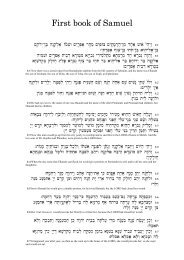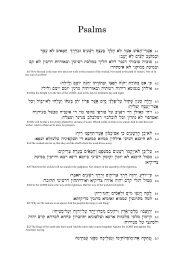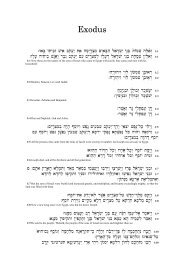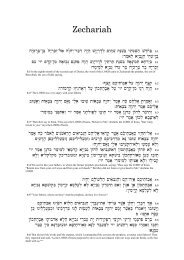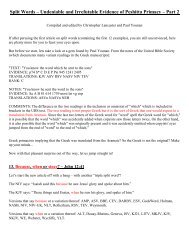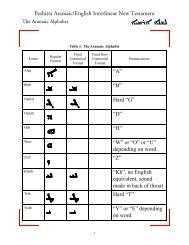ana translation
Untitled - Peshitta Aramaic/English Interlinear New Testament
Untitled - Peshitta Aramaic/English Interlinear New Testament
- No tags were found...
You also want an ePaper? Increase the reach of your titles
YUMPU automatically turns print PDFs into web optimized ePapers that Google loves.
INTRODUCTION<br />
xlix<br />
(apparently a place visited by him in a journey<br />
from his home to<br />
Tur-'Abdin). The Four Epistles were published from this MS in<br />
photographic facsimile by Dr. I. H. Hall, The Syrian Antilegomena<br />
Epistles (1886). From it were derived many corrections of the text<br />
of our Epistles in the New York edition (N) of 1886, as (e.g.)<br />
O (for >) prefix to UoJA^D (2 Pet. i. 3), U?OO (16. 4), JiGl (ii. 1),<br />
U^ (ib. 17), insertion of<br />
(iii. 5),<br />
^ and J2J* (ib. 13) also of<br />
;<br />
(2 Joh. 5),<br />
^OldlyOda (2 Joh. 6), .OOlLiJ (3 Joh. 9) and of<br />
;<br />
(Jud. 10).<br />
But the editor has not followed its omission of the<br />
negative (2 Pet. iii. 10), nor its readings, ]> (2 Pet. iii. 1),<br />
iAco<br />
(3 Joh. 10).<br />
In all these places, it agrees with the A-group ;<br />
and on<br />
the whole, its text is about on a par with that of Cod. 3.<br />
Cod. 13. (Wetstein's MS, Amsterdam, Biblioih. des Eemonstr. Gemeente,<br />
No. 184.)<br />
This MS now exhibits only the Acts and Epistles, but the numbering<br />
of the quires (quinions)<br />
shows that it has lost the first 173<br />
leaves (17 quinions and 3 leaves of an eighteenth), no doubt containing<br />
the Gospels.* It now begins with Acts i. 1 (on<br />
the fourth<br />
leaf of quinion 18, having evidently been intentionally divided at that<br />
point from the preceding quires).<br />
The order of the Epistles is, (1) the<br />
Three Catholic of the Peshitta, (2) the Pauline, (3) the Four. The<br />
scribe Cuphar (fQQO) states in the colophon that he began<br />
it in a<br />
monastery of Gargar, and completed it in the monastery of the Theotokos<br />
at Mardin, A.Gr. 1781 (A.D. 1470). Gargar<br />
is a bishop's see,<br />
suffragan to Melitene,f belonging therefore to the specially Jacobite<br />
region of N.E. Mesopotamia. Thus, in place as well as in date, it is<br />
closely akin to Cod. 11. In text, however, it leans less towards the<br />
A-type than either Cod. 11 or Cod. 3. Yet it agrees with the A-text<br />
in a few of the places above cited (under Codd. 3, 11); scil., 2 Pet. ii. 17,<br />
iii. 10, 13 ;<br />
3 Joh. 10 ;<br />
Jud. 10 :<br />
and, moreover, it has the very important<br />
A-readings lwJ&-M (<br />
2 Pet. ii. 18), O prefixed to .J-So (Jud. 4),<br />
}AjiQ_**2 (for AA-M, ib. 7), none of which is given by 11, and only<br />
the first<br />
by 3. In the last-named place, however, it has evidently been<br />
* As these 173 leaves would give room for other matter besides the Gospels, it<br />
may be that the Apocalypse followed them (as in Cod. 12).<br />
t Assemani, Biblioth. Orient., t. ii, p. 260.



